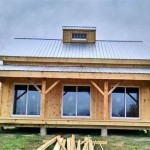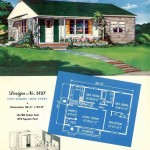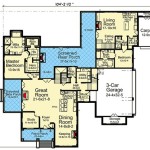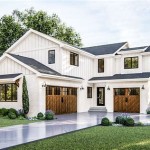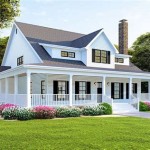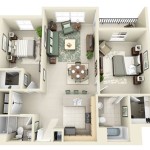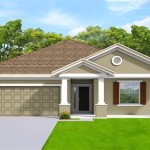```html
The Enduring Appeal and Practical Considerations of Houses With Open Floor Plans
The open floor plan has emerged as a dominant trend in residential architecture over the past several decades. Characterized by the elimination of walls that traditionally separate distinct living spaces, such as the kitchen, living room, and dining area, the open floor plan creates a larger, more fluid, and interconnected environment within the home. This design philosophy impacts not only the aesthetic of a house but also its functionality, lifestyle suitability, and perceived value.
Historically, houses were often compartmentalized into smaller, distinct rooms, each serving a specific purpose. This design reflected a different era focused on formality and defined roles within the household. However, as lifestyles evolved and families sought greater flexibility and interaction, the open floor plan gained traction as a desirable alternative. The shift reflects a societal preference for casual living, enhanced social interaction within the home, and a desire for maximizing natural light penetration.
The appeal of open floor plans extends beyond mere aesthetics. The perceived spaciousness is often a major draw, particularly in smaller homes where creating an illusion of greater square footage is highly valued. The uninterrupted sightlines and enhanced flow of movement contribute to a sense of freedom and ease within the living space. Furthermore, the open layout facilitates effortless entertaining, allowing hosts to remain connected with guests while preparing food or managing other hosting duties.
Enhanced Social Interaction and Family Connectivity
One of the primary advantages of an open floor plan is its ability to foster social interaction and family connectivity. By removing the barriers of walls, family members are encouraged to spend more time together in a shared space, even while engaging in different activities. For example, a parent can supervise children playing in the living area while simultaneously preparing meals in the kitchen. This promotes a sense of togetherness and strengthens familial bonds.
In a traditional, compartmentalized home, individuals might be isolated in separate rooms, leading to diminished interaction and a feeling of disconnect. The open floor plan mitigates this issue by creating a central hub where family members can easily interact and communicate. This is particularly beneficial for families with young children, as it allows for better monitoring and supervision. Moreover, the open layout is conducive to casual conversations and spontaneous interactions, fostering a sense of community within the household.
The social benefits extend beyond the immediate family. Open floor plans are ideal for hosting gatherings and entertaining guests. The seamless flow between the kitchen, dining area, and living room allows for easy mingling and interaction. Hosts can effortlessly prepare food and drinks while remaining engaged with their guests, creating a more relaxed and inclusive atmosphere. The open space also provides ample room for guests to move around and socialize comfortably.
However, while promoting interaction, the lack of defined spaces can also present challenges. Maintaining a balance between togetherness and individual privacy is crucial. Strategies such as incorporating designated quiet zones or utilizing furniture to create visual divisions can help address this issue. The key is to design the open floor plan in a way that supports both social interaction and individual needs.
Increased Natural Light and Perceived Spaciousness
Open floor plans invariably contribute to increased natural light penetration throughout the home. With fewer walls obstructing the flow of sunlight, natural light can reach deeper into the interior spaces, creating a brighter and more inviting atmosphere. This is particularly beneficial in areas that might otherwise be dark or gloomy due to limited window access.
The abundance of natural light not only enhances the aesthetic appeal of the home but also has positive effects on mood and well-being. Studies have shown that exposure to natural light can improve mood, reduce stress, and increase energy levels. By maximizing natural light penetration, open floor plans contribute to a healthier and more comfortable living environment.
Furthermore, the open layout visually expands the perceived square footage of the home. The absence of walls creates a sense of spaciousness and freedom, making the living area feel larger and more open than it actually is. This is particularly advantageous in smaller homes where maximizing the feeling of space is paramount. The uninterrupted sightlines and seamless flow between rooms contribute to a sense of airiness and openness.
The visual impact of an open floor plan can be further enhanced by incorporating strategic design elements, such as large windows, skylights, and light-colored paint. These elements work together to amplify the effects of natural light and create an even more spacious and inviting atmosphere. Thoughtful furniture placement and minimal clutter also contribute to the overall feeling of openness and airiness.
While natural light is a significant advantage, it's important to consider the potential for glare and overheating, especially in climates with intense sunlight. Implementing strategies such as window treatments, overhangs, or strategically placed landscaping can help mitigate these issues and maintain a comfortable indoor environment.
Potential Drawbacks and Considerations
Despite the numerous advantages, open floor plans also present potential drawbacks that must be carefully considered during the design process. One of the most common concerns is noise control. Without walls to contain sound, noise can easily travel throughout the open space, potentially disrupting activities or creating a sense of cacophony.
In an open floor plan, sounds from the kitchen, such as cooking noises or dishwashing, can easily permeate the living area, potentially interfering with conversations or relaxation. Similarly, sounds from the living area, such as television or music, can disrupt activities in the kitchen or dining area. This lack of acoustic separation can be particularly problematic for individuals who are sensitive to noise or require a quiet environment for work or study.
Another consideration is the lack of privacy. The open layout can make it difficult to find a quiet retreat or escape from the hustle and bustle of daily life. Without walls to provide visual and acoustic separation, it can be challenging to maintain a sense of privacy, especially when multiple individuals are occupying the same space. This can be particularly problematic for individuals who value their alone time or require a dedicated space for work or study.
Furthermore, open floor plans can be more challenging to heat and cool efficiently. The large, open space may require a more powerful HVAC system to maintain a consistent temperature throughout the entire area. This can result in higher energy bills and increased environmental impact. Additionally, the lack of walls can make it more difficult to control the temperature in specific zones, leading to discomfort or inefficiency.
Finally, maintaining cleanliness and organization can be more challenging in an open floor plan. The lack of walls means that clutter and mess are more visible and can quickly spread throughout the entire space. Regular cleaning and organization are essential to maintain a tidy and aesthetically pleasing living environment. Strategies such as incorporating ample storage solutions and establishing designated zones for different activities can help to mitigate this issue.
In conclusion, the decision to embrace an open floor plan involves weighing both the advantages and disadvantages in relation to individual lifestyle, family needs, and personal preferences. A well-designed open floor plan can enhance social interaction, maximize natural light, and create a spacious and inviting living environment. However, careful consideration must be given to potential drawbacks such as noise control, lack of privacy, and energy efficiency. By addressing these concerns through thoughtful design and planning, it is possible to create an open floor plan that is both functional and aesthetically pleasing.
```
Pros And Cons Of An Open Concept Floor Plan Generation Homes Nw

Modern Open Floor House Plans Blog Eplans Com
:max_bytes(150000):strip_icc()/1660-Union-Church-Rd-Watkinsville-Ga-Real-Estate-Photography-Mouve-Media-Web-9-77b64e3a6fde4361833f0234ba491e29.jpg?strip=all)
18 Open Floor House Plans Built For Entertaining

Open Floor Plans Build A Home With Smart Layout Blog Dreamhomesource Com

Pros And Cons Of Open Concept Floor Plans

House Design Trends What S Popular In Cur Floor Plans Extra Space Storage

30 Gorgeous Open Floor Plan Ideas How To Design Concept Spaces

Free Editable Open Floor Plans Edrawmax

Classic House Plans Open Floor Concept

Pros And Cons Of Open Concept Floor Plans

